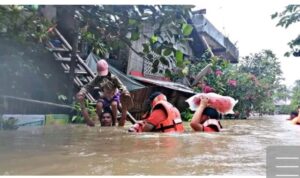

Foreign news.

The death toll has risen to 42 and more people were found missing after a strong overnight downpour flooded a number of towns in the Maguindanao province in the southern Philippines, a local official said Friday.
Naguib Sinarimbo, interior and local government minister of Bangsamoro Autonomous Region in Muslim Mindanao (BARMM), said 27 people were killed in Datu Odin Sinsuat, 10 in Datu Blah Sinsuat, and five in Upi.
Maguindanao is a province in the BARMM.
The victims died from drowning and landslides, he said, warning the causalities may rise further as the rescue operation was going on.
Nine towns in Maguindanao were severely flooded, and most parts of Cotabato City in the BARMM were underwater for the first time in years.
The BARMM has “raised our alert level to red this morning”, Sinarimbo added.
Army Maj.-Gen. Roy Galido, commander of the Army’s 6th Infantry Division, told a radio interview that dozens of houses in Datu Odin Sinsuat were buried in the landslide.
Nasrullah Imam, head of the Maguindanao provincial disaster risk reduction and management office, said troops and police were deployed in place to help rescue and evacuate local residents.
The Office of Civil Defense said the approaching tropical storm Nalgae, which is expected to make landfall by the weekend in the country, heavily affected, particularly, BARMM and the Western Visayas region in the central Philippines.
The Philippine Atmospheric, Geophysical and Astronomical Services Administration forecast that Nalgae will intensify further and “may reach severe tropical storm category within 12 hours”.
The National Weather Bureau said Nalgae will bring heavy rain this weekend in many areas across the Southeast Asian country.
Dozens of provinces and cities were under storm alerts, including Metro Manila.
The coast guard said the tropical storm stranded over 4,500 passengers, drivers and cargo helpers in ports in Bicol, Southern Tagalog and Visayas regions.
Over 100 flights are scheduled to be cancelled in the coming days.
The bureau warned that flooding and rain-induced landslides are expected, especially in areas highly susceptible to these hazards and in localities with significant antecedent rainfall.
The Philippines is one of the most disaster-prone countries globally, mainly due to its location in the Pacific Ring of Fire and Pacific typhoon belt.
On average, the archipelagic country experiences 20 typhoons yearly, some of which are intense and destructive.
In April, tropical storm Megi dumped rains in central and southern parts of the Philippines, inundating many areas and causing landslides, resulting in over 220 deaths.
Edited by Dada Ahmed.
SOURCE: Xinhua

